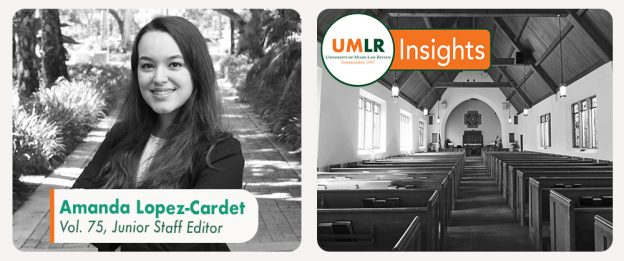AMANDA LOPEZ-CARDET—On November 25, 2020, the United States Supreme Court decided Roman Catholic Diocese of Brooklyn v. Cuomo. It marks the first time since the beginning of the COVID-19 pandemic that the Court has granted an application for injunctive relief by a house of worship, invoking the First Amendment Free Exercise Clause against executive orders meant to curb the spread of COVID-19. This decision also reveals the difference in the Court’s dynamic since the addition of Justice Amy Coney Barrett.
New York Governor Andrew Cuomo issued Executive Order 202.68 on October 6, 2020, to help combat rising COVID-19 cases. The order designated certain geographic areas as red, orange, and yellow zones according to the area’s reported COVID-19 numbers—the higher the infection rate, the higher the restrictions the City implemented. Houses of worship located in an orange zone were limited to twenty-five occupants, while those in a red zone were limited to only ten occupants.
Two houses of worship—the Roman Catholic Diocese of Brooklyn, New York and Agudath Israel of America—each filed an emergency application for injunctive relief against Governor Cuomo’s executive order. The parties alleged that they were treated more harshly and given far more restrictions under the executive order than secular facilities in the same color zone. Both applications were addressed in one opinion by the Court.
Roman Catholic Diocese of Brooklyn began garnering public attention as several outside institutions became involved. The American Medical Association filed an amicus brief in support of the Governor’s order, declaring that “religious services are among the riskiest activities” even when protective measures are implemented. Conversely, First Liberty Institute used its amicus brief to accuse Governor Cuomo of discriminating against houses of worship by refusing to subject many secular facilities to strict capacity restrictions, because they were classified as essential businesses.
In a 5-4 per curiam decision, the Supreme Court enjoined Governor Cuomo’s enforcement of restrictions on houses of worship. The majority opinion insisted:
“Members of this Court are not public health experts, and we should respect the judgment of those with special expertise and responsibility in this area. But even in a pandemic, the Constitution cannot be put away and forgotten. The restrictions at issue here, by effectively barring many from attending religious services, strike at the very heart of the First Amendment’s guarantee of religious liberty.”
While the Court found that “[s]temming the spread of COVID-19 is unquestionably a compelling interest,” it held that Governor Cuomo’s executive order enacted regulations that were too restrictive, more so than any other regulations brought before the Court. The majority opinion suggested that there were less restrictive ways to implement public health regulations inside houses of worship while not violating the constitutional freedom to exercise religion.
Chief Justice John Roberts did not agree with the majority opinion. Instead, he found that neither house of worship was entitled to injunctive relief because by the time the Court decided this case, the executive order was revised and did not affect the occupancy of either applicant. However, Chief Justice Roberts did take the opportunity to caution the majority that “it is a significant matter to override determinations made by public health officials concerning what is necessary for public safety in the midst of a deadly pandemic.”
Justice Sonia Sotomayor, joined by Justice Elena Kagan, was more direct in her dissent. Justice Sotomayor wrote that the majority opinion “will only exacerbate the Nation’s suffering.” She claimed that Governor Cuomo’s executive order did not endanger religious freedoms or institutions because religious institutions were treated “equally or more favorably than comparable secular institutions” under the executive order.
Roman Catholic Diocese of Brooklyn not only shows the effect COVID-19 has had on the Free Exercise Clause, but it also highlights the major shift in the Court since Justice Ruth Bader Ginsburg’s passing in September 2020. The late Justice Ginsburg was instrumental in the Court’s past denials of injunctive relief for houses of worship. In May 2020, the Court denied a California church’s application for injunctive relief in South Bay United Pentecostal Church v. Newsom after the California Governor’s executive order limited attendance in houses of worship to twenty-five percent capacity or a maximum of 100 members. Similarly, two months later, the Court denied a Nevada church’s application in Calvary Chapel Dayton Valley v. Sisolak after the Nevada Governor signed an executive order limiting attendance in houses of worship to fifty people. In both cases, Chief Justice Roberts was the swing vote as he sided with the four liberal justices—including Justice Ginsburg—against granting injunctive relief for houses of worship.
However, because Justice Barrett’s appointment to the Court cemented the conservative justices’ majority, Chief Justice Roberts’ vote no longer holds the power it once did. This is especially evident from the Court’s most recent decision regarding the Free Exercise Clause in South Bay United Pentecostal Church v. Newsom, decided on February 5, 2021—only two months after Roman Catholic Diocese of Brooklyn. California houses of worship—including the applicant from the May 2020 decision with the same case name—filed an application for injunctive relief. In its February 2021 ruling, the Court granted the application this time, holding that the Free Exercise Clause had been violated. Justice Barrett took the opportunity to publish her first signed opinion since joining the Court, which foreshadows the importance with which she will treat future Free Exercise Clause cases. This decision further sets the tone for future Court decisions addressing religious freedom, especially during the pandemic.
Roman Catholic Diocese of Brooklyn is one of the first demonstrations of the Supreme Court’s new dynamic since the addition of Justice Barrett. It provides a glimpse as to how the Court will handle future public health crises that conflict with First Amendment freedoms. As Justice Samuel Alito noted, “[t]he COVID crisis has served as a sort of constitutional stress test,” and this pandemic is far from over.






